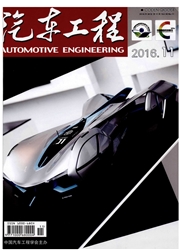

 中文摘要:
中文摘要:
在1/4车辆模型的基础上加入动力总成悬置系统而建立了汽车前轴垂向振动模型,基于该模型分析不同悬置系统设计对系统固有属性和汽车行驶动力学性能的影响。将线性2自由度汽车模型与动力总成悬置系统相结合,建立3自由度汽车侧向动力学模型,应用该模型计算整车在转向角阶跃输入和角脉冲输入下的响应,以分析不同悬置系统设计对汽车转向稳态与瞬态特性的影响。结果显示,动力总成悬置系统对车身加速度的影响很大,但对悬架动挠度和车轮动载荷影响很小;随着悬置系统侧向偏频的升高,汽车的横摆谐振频率增高,谐振峰值增大,而相位滞后角的变化很小。
 英文摘要:
英文摘要:
Powertrain mounting system (PMS) is added on a 1/4 vehicle model to form a vertical vibration model for vehicle front axle, based on which the effects of different designs of PMS on the natural properties of sys- tem and the driving dynamic performance of vehicle are analyzed. Meanwhile, a 2 DOF linear vehicle model is com- bined with PMS to build a 3 DOF vehicle lateral dynamic model, with which the vehicle responses to both the step and pulse input of steering angle are calculated to analyze the effects of different designs of PMS on both the steady state and transient steering characteristics of vehicle. The results indicate that PMS has significant effects on vehicle body acceleration, but only has a trivial effect on the dynamic deflection of suspension and the dynamic load of wheel. With the increase in lateral partial frequency of PMS, yaw resonance frequency rises, resonance peak goes up but phase angle only has little change.
 同期刊论文项目
同期刊论文项目
 同项目期刊论文
同项目期刊论文
 期刊信息
期刊信息
